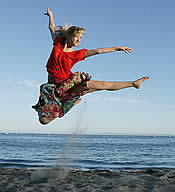
by Rachel Gardner, 15, Ali Tahir, 14, and Carmela Verderame, 10
Y-Press Inc.
SANTA BARBARA, CA—Dancing has swept American popular culture, from TV shows such as “Glee” and “So You Think You Can Dance” to “High School Musical” productions on the stage and screen.
But one organization believes dancing can do more than just entertain.
Everybody Dance Now (EDN) believes dancing can bring a community together.
Jackie Rotman, an eighteen-year-old sophomore at Stanford University, founded EDN four years ago. Since then, EDN has made dancers out of nearly 850 young people and entertained thousands more.
Jackie has loved to dance since she was a child. “It’s really given me a place to make friends, a place to be confident, a place to perform and express myself,” she said. She wanted to share her joy with others, so at age 12, she and a friend decided to perform for some teenagers with disabilities in their hometown of Santa Barbara.
“It was just the most incredible afternoon because what ended up happening was our music stopped halfway through the dance, so the people in the audience had us do it again, and it stopped again and they started shouting out, ‘We want to dance!’” she said.
“So we invited all these people onstage to dance with my friend and me and we saw how happy they were, how joyful they were and how confident they felt and just how connected the whole entire room was through like dance,” she continued. “It really showed me that dance could be more than just some extracurricular activity that I did myself, but could be something to share with other people, to empower them and bring them happiness and all these positive feelings and opportunities.”
Acting on conviction
Two years later, Jackie was ready to act on her convictions. She asked some of her friends if they would help her teach dance classes to youth who may not have the opportunities they had. They decided on hip-hop classes to appeal to the greatest number of youth. Their success surprised everyone.
“I just started teaching without any teaching experience and I kind of learned as I went, and it was a really positive opportunity for me and for the kids,” she said. “I think that because I was so close in age to them, I could really connect better.”
EDN partners with other nonprofit service groups, such as Girls and Boys Clubs and after-school programs, to offer free weekly classes. Most teachers are youth (the Santa Barbara unit is run entirely by high school students), who not only teach classes but write grant applications as well, because nonprofit foundations fund most programming, Jackie said.
Olivia Berci, 14, is the public relations manager and coordinator of the EDN quarterly cultural dance classes in Santa Barbara. She believes she has benefited from the classes as much as her students.
“I know that I have gained so much from this,” she said. “I’m much more confident. I’ve learned how to communicate better with adults.”
A typical EDN class is made up of 12-15 students, ages 8-18, and one instructor. Most classes focus on hip-hop dancing. “They enjoy it because hip hop is cool. I think they can express themselves more freely than if we were to do jazz or ballet,” said Olivia.
EDN holds about 16 to 18 classes between its two locations. Though youth are initially the recipients of the program, they are given opportunities to perform for others “so that they can feel the joy of giving back,” Jackie said.
It’s all about not just teaching dance steps, but really empowering these kids and building self-esteem in them, and you really see them transformed through our program,” she added.
EDN recently gained the national spotlight after being honored by the MTV show America’s Best Dance Crew. They were one of five groups in the nation to receive $10,000 and a private dance lesson from the season five best dance crew.




